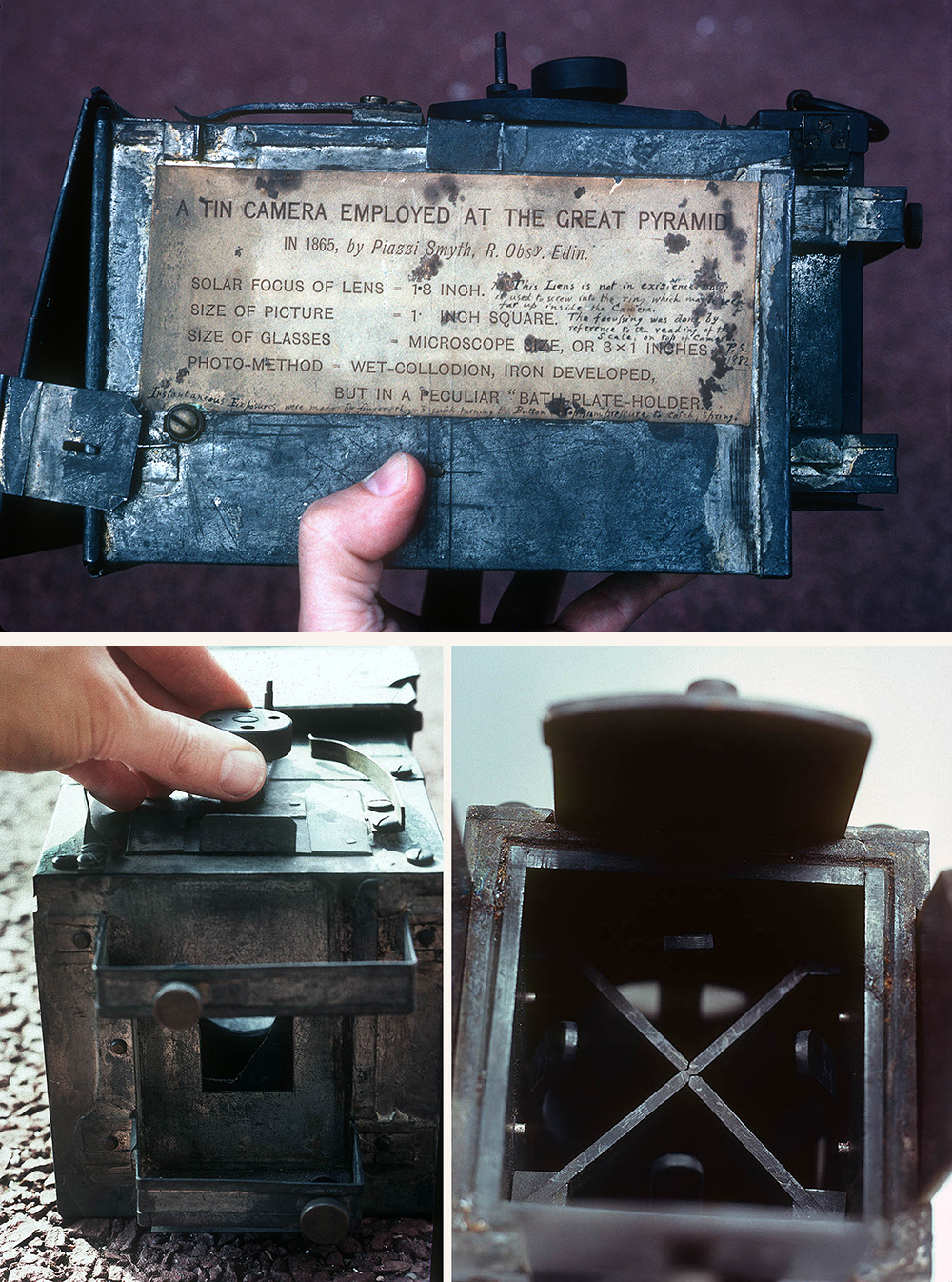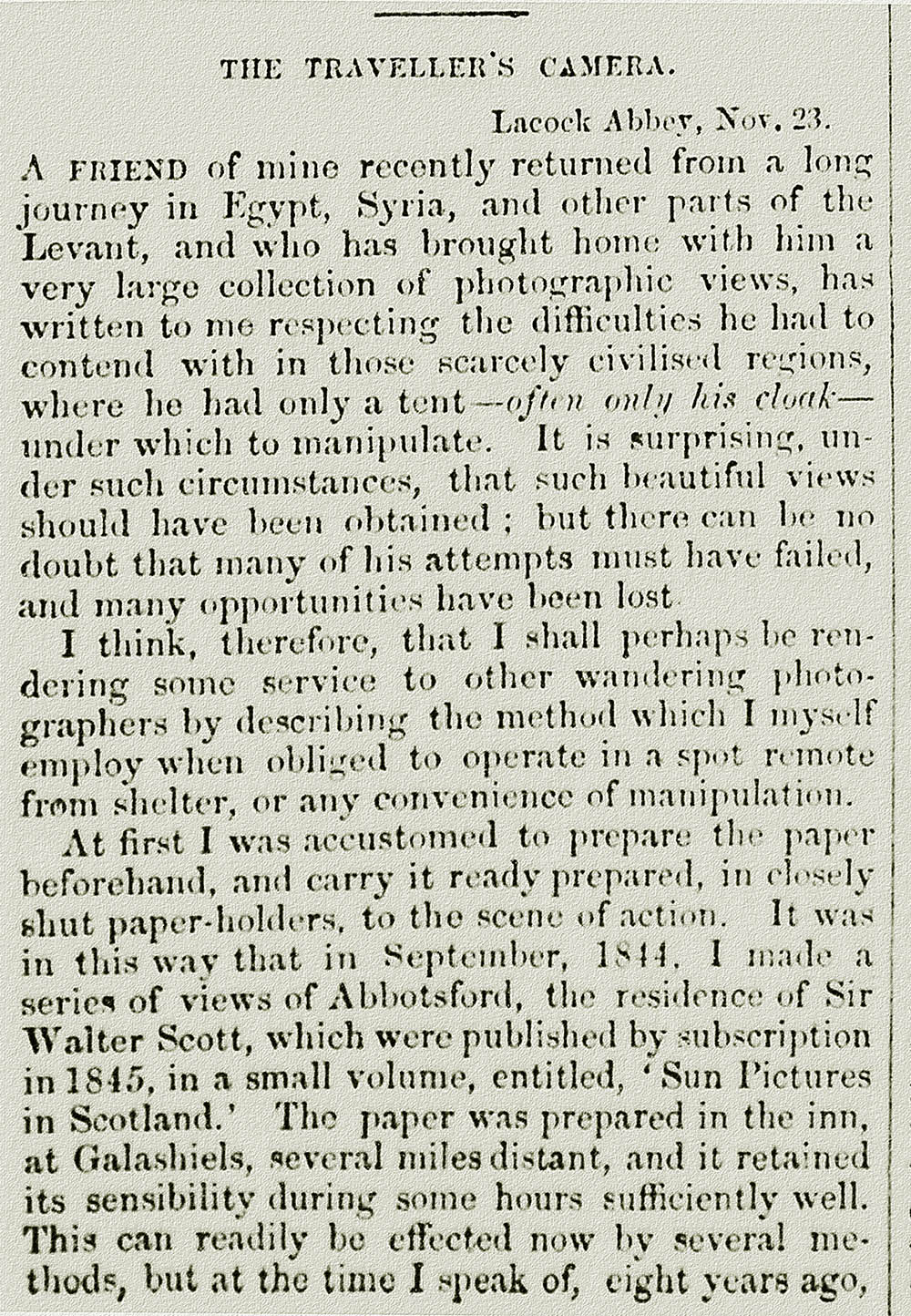At the risk of intruding upon Roger Watson’s hunt for Talbot’s equipment (and we look forward to more blogs on this topic from him soon) there is a particular piece of kit that has always intrigued me, Talbot’s Traveller’s Camera. Sadly, rather like the manuscript basis for Grant Romer’s Io-types, the camera is known to exist only as a published description. However, it is yet another proof of Henry Talbot’s ingenious mind.

Ben Shahn depicted this itinerant photographer in 1938, before the advent of Polaroid and long before digital imaging. Working on the street, the tintype photographer knew that he had only a brief opportunity to reach into a customer’s purse. A trip to a darkroom would have meant a lost sale, so he developed his tintype directly in the camera. That shiny cylinder just behind his wrist held the chemicals necessary to quickly develop and fix the plate. No diversion to the darkroom was needed, tempting the customer with his own image right on the spot.
There are twenty-three plates in Sun Pictures in Scotland – the first thirteen are Talbot’s usual ‘whole-plate’ size, approximately 16×21 cm. – and the final ten are ‘quarter-plate’, about 8×10 cm., these latter ones arranged as pairs on a page. But with only twenty-three plates, why virtually duplicate several of the scenes? Talbot certainly had plenty of other photographs available from this expedition. I’ve heard various theories put forth over the years. There is a persistent story hat he was experimenting with enlarging, but even a cursory examination of the negatives shows that this was not the case. Talbot employed cameras of both sizes and one could understand if he chose the more compact one for a particularly difficult to reach area. But the above were some of the easiest points in his journey and his carriage could have carried either size. Was there a journalistic or stylistic attempt at positioning two smaller ones on a page? The seemingly arbitrary pairings makes that unlikely. Was one camera size for Talbot and the other a backup for his colleague Nicolaas Henneman? Reasonable insurance, and of course Henneman might have found it useful to stock two sizes of loose prints for sale, but why did Henry duplicate the images in his published book?
The trigger for Talbot might have been a letter that he received from his friend, the Rev. George Wilson Bridges, a terribly enthusiastic calotypist who took some fantastic images but whose ambitions often outran his expertise. Bridges had just returned from the Middle East when, on 9 November 1852, he wrote to Talbot “you are aware of the difficulties I had to contend with, not only in taking the negatives where I had but scanty material, & no convenient place, better than my tent – often no other than my cloak, under which to manipulate.” Talbot echoed this in his letter to Reeve: “A FRIEND of mine recently returned from a long journey in Egypt, Syria, and other parts of the Levant, and who has brought home with him a very large collection of photographic views, has written to me respecting the difficulties he had to contend with in those scarcely civilised regions, where he had only a tent – often only his cloak – under which to manipulate. It is surprising, under such circumstances, that such beautiful views should have been obtained; but there can be no doubt that many of his attempts must have failed, and many opportunities have been lost.”
Talbot had attempted sensitising the paper in advance, and then carrying “it ready prepared, in closely shut paper-holders, to the scene of action. It was in this way that in September, 1844, I made a series of views of Abbotsford, the residence of Sir Walter Scott, which were published by subscription in 1845, in a small volume, entitled, ‘Sun Pictures in Scotland.’ The paper was prepared in the inn, at Galashiels, several miles distant, and it retained its sensibility during some hours sufficiently well.” But he goes on to point out that these sheets sometimes failed, which “required all the principal points of view to be taken in duplicate as a necessary precaution.” He had to intentionally reduce the sensitivity of the negative paper in order to make it more stable. “These inconveniences led me to the invention of a modus operandi to which, if it has not been described before, as I believe it has not, I propose to give the name of the Traveller’s Camera, as it greatly facilitates the production of these beautiful pictures during the hardships and privations of foreign travel. ”
Now, there is some ambiguity here. Did he make or at least conceive of his Traveller’s Camera in 1844? or closer to the time of the letter? His language indicates that he actually made the device but it is unclear just when. “First, I mount the camera itself upon a board … I then make a kind of table, or support, beneath the surface of which are sunk or concealed three troughs.” The first of these was filled with a solution of silver nitrate, the second a developer, either gallic acid or ferrous sulphate, and the third with plain water. “The usual paper-holder is dispensed with, but instead of it there is a simple frame, to which a sheet of paper or a pane of glass can be attached from behind, and taken away again, while the frame remains in the camera. The. upper part of the frame carries a long handle, passing through the lid of the camera.” The camera slid forward or back on the platform, with marks aligning it over the three baths. Talbot set out in the morning with his paper already iodised, the first step in making calotype paper but not yet sensitive to light. He could put a sheet in the camera in broad daylight, then close the camera up, align over the silver bath and dip the paper in to sensitise it. Re-positioned behind the lens, the exposure was made. The camera body was then shifted to the second mark and the paper plunged into the developer. Once complete, the bath of plain water came into play, which served both as a means of stopping development and as a dark wet storage place for the exposed and developed negative. The final fixing and washing could be deferred until he was back home.
Could Talbot have been experimenting with this when he was in Scotland in 1844? Were the smaller negatives field tests of this new approach? The subscribers to Sun Pictures in Scotland, mostly the great and the good strong-armed into purchase by Lady Elisabeth, were unlikely to appreciate this technical breakthrough and there was no letterpress to explain it.
Or was the inclusion of the duplication and mixed sizes simply another inexplicable publishing decision made by Talbot?
I think that Talbot’s A mountain rivulet which flows at the foot of Doune Castle is one of his most thoughtful and complex images. But why would he choose his smaller negative for inclusion in Sun Pictures, relegating the larger one to single prints? It just doesn’t make sense.
 So, the challenge to Roger – and indeed to all our loyal readers – please seek out and find the carcass of The Traveller’s Camera. Perhaps that physical evidence will expand our knowledge of this creative effort. And just perhaps it will shed some light on the seemingly inexplicable duplication of images in Sun Pictures in Scotland.
So, the challenge to Roger – and indeed to all our loyal readers – please seek out and find the carcass of The Traveller’s Camera. Perhaps that physical evidence will expand our knowledge of this creative effort. And just perhaps it will shed some light on the seemingly inexplicable duplication of images in Sun Pictures in Scotland.• Questions or Comments? Please contact digitalsupport@bodleian.ox.ac.uk • Ben Shahn, Itinerant Photographer in Columbus, Ohio, August 1938; Library of Congress. • Charles Piazzi Smyth, Metal Camera with Quad-Plateholder, used in Egypt in 1865; the Royal Observatory, Edinburgh. A pdf about their expedition is here. • WHFT, “The Traveller’s Camera,” The Literary Gazette, no. 1871, 27 November 1852, p. 876. The version of this letter in the online Correspondence of William Henry Fox Talbot includes a transcription Talbot’s draft manuscript as well as the final published version: Document No. 05186. • WHFT, A Mountain Rivulet which flows at the base of Doune Castle, salted paper print from a calotype negative, October 1844, private collection; Schaaf 17.






